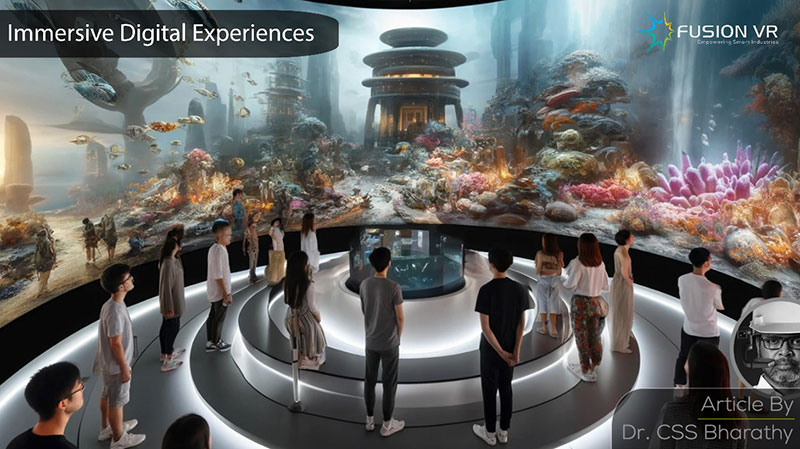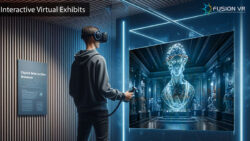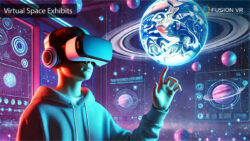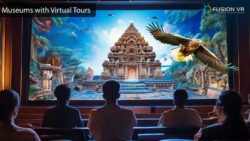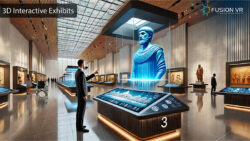Museums have consistently been entrusted with the responsibility of guarding valuable artifacts and knowledge concerning human history, art, culture etc. in addition to everything related to the natural wonders of the planet we live in. We have seen a resurgence in interest in museums across the world as their role in showcasing and propagating knowledge is being appreciated. There is a movement to shed the image of being boring to one that is exciting. This transformation is driven by the advent of immersive digital technologies such as virtual reality and augmented reality along with a host of digital tools that are crucial to creating immersive and engaging experiences.
What we need to explore here is how this transformation is happening using these prominent technologies in the way we experience and enjoy museums today. Museums, existing and new, have made it a high priority to incorporate immersive digital experiences to add value to the visitor experiences that are engaging and enriching. The key technologies that are being leveraged to deliver such museum experiences are virtual reality (VR) and Augmented Reality (AR) plus a host of digital tools and techniques to support the creation and delivery of digital interactive experiences.
Virtual Reality digitally creates a highly realistic virtual environment that is experienced with the aid of a specially designed and sophisticated headset. This headset completely covers the user’s eyes and ensures total immersion in the virtual world. The headset has the optics, electronics and high-resolution displays to provide a real-life experience that allows the user to navigate freely in the virtual world and six degrees of freedom. The visitor turns around and sees their environment in the same way they would in a real environment. The level of realism delivered by the VR museum experience is what makes it a fantastic medium for creating a time travel experience.
Virtual reality is enabling interactive museums to provide fully immersive exhibits and tours that are accessible to everyone irrespective of where they live. These virtual reality museum tours completely replicate a physical museum in a virtual reality experience. It enables each visitor to virtually enter and walk through a museum facility as they would in real life. It allows a visitor to walk up to a front desk and converse with a virtual avatar of a real customer support person and obtain the assistance needed. The virtual tour enables the visitor to navigate through the museum and get up close to a digital museum recreation of an actual exhibit and explore its various features and specialities without being enslaved to a time limit or bothered by other visitors and distractions. The British Museum and the Louvre have developed VR tours that provide such experiences with their collections, like the VR experience of Leonardo Da Vinci’s, Mona Lisa, which can only be seen from afar in the real world. In this case, the immersive virtual experience is therefore more fulfilling than even a direct experience.
Museums are also using virtual reality to enable a virtual time travel experience to the past by reconstructing events, sites and experiences that have been lost to the ravages of time. The ancient cities, their battles, conquests and many great as well as ordinary events can be brought back to life through a virtual reality headset. Such experiences are being established in museums where visitors need not even undertake the trouble of donning a headset. Multiple VR headsets are fixed onto the wall and visitors position their faces on it and view the experience. The experience runs on a continuous loop and can be enjoyed multiple times. The viewer experience is unencumbered and makes it easier for anyone to experience it. This time travel immersive experience is not only enthralling but also enables delivery of a unique learning experience. Feeling that one is part of the scene gives the feeling of being an eyewitness and leaves an indelible impression in their minds. The educational content designed into such experiences assures knowledge retention.
Augmented reality is also delivering immersive museum experiences by overlaying digitally created content on the user’s environment as viewed through their digital devices such as smartphones, tablets, wearables etc. The content delivered could be contextual and location specific depending on the needs and preferences of the user. The juxtaposition of content such as animation, 3D models etc. brings the surrounding environment to life. Museum 2.0 solution providers such as Fusion VR collaborate with museums to create an immersive display enclosure that visitors enter and begin to experience an environment that comes alive. Augmented reality applications on their devices and wearables bring to life the content around them making the visitor feel an immense level of immersiveness. Visitors are able to view animations or 3D models of artifacts that are designed to be engaging and interactive. These experiences are also gamified to maximize engagement and make it more interesting to the viewer. Such an experience is on display in the National Museum of Singapore.
The kind of immersive experiences generated by augmented reality may not be immersive in the truest sense, but the way it engages the mind, makes the user forget about the surroundings and get drawn into the experience that is in many ways an immersive experience. In many cases, these experiences blend the real and digital. The Museum of Natural history has developed AR applications that allow the user to witness how prehistoric animals looked by superimposing digital reconstruction of their flesh, skin and fur on the skeletons on display. These digital models can be animated for visitors to witness their movement and also see them in their natural environment. These can be multi-sensory experiences that include among visual experiences, other stimuli such as audio, tactile and even olfactory (sense of smell). Incorporating these makes these museum experiences much more closer to a real experience. In addition to this, such augmented reality experiences can be gamified with puzzles, quizzes and activities such as a virtual treasure hunt which in most cases appeals to all kids and youngsters. Such gamification initiatives can be coupled with rewards such as badges, certificates etc.
Digital museum experiences have an unseen dimension to it in museums, one that is used to enhance visitor experiences. We’re in the age of big data analysis and museums are harnessing the data churned out from visitor experiences that are mined and analyzed to obtain insights and intelligence about visitor preferences and trends. This is extremely important to curate visitor experiences that draw more people to visit museums and also develop new experiences that would continue to attract them. Museum tours can be customized based on those preferences and thereby ensuring maximized engagement and customer satisfaction. The future for immersive interactive museums is very promising as we see more and more government and private entities interested in the creation of digital museum experiences.
While we have these exciting technologies in museums available in addition to the top-class execution capabilities, these immersive exhibits also require highly trained personnel to maintain them. The biggest hurdle towards the transformation of traditional museums towards digital immersive museums is financing new projects. This is where companies like Fusion VR help museums to design and develop solutions that are meaningful and cost-effective from a capex as well as operating cost perspective. I encourage the reader to explore our Museum 2.0 webpage to learn more about AR VR Museums and Corporate Experience Centers and also reach out to us for further information and assistance towards creating unforgettable visitor experiences.

